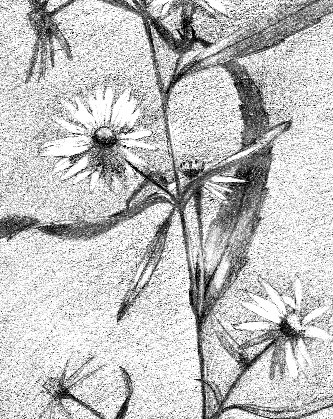Chesapeake Bay's Independent Newspaper ~ Since 1993
1629 Forest Drive, Annapolis, MD 21403 ~ 410-626-9888
Volume XVII, Issue 49 ~ December 3 - December 9, 2009
Home \\ Correspondence \\ from the Editor \\ Submit a Letter \\ Classifieds \\ Contact Us
Dining Guide \\ Home & Garden Guide \\ Archives \\ Distribution Locations \\ Advertising
![]()


|
Earth Journal
by Gary Pendleton |
|
Scientific name: Symphyotrichum lateriflorum What to look for: A spindly, multi-branched plant that grows from one to four feet high and is loaded with white daisy-like flowers. Where to look: Sunny, well-drained fields and edges where the mowers can’t reach. |
 Autumn’s Last Wildflower
Autumn’s Last Wildflower
Calico aster
Whether you live in the country or in town, calico aster is probably in the neighborhood. It’s one of a number of species of small daisy-like flowers that bloom from mid-summer until they are killed by the first autumn frost.
From a distance, this aster is a spray of white. Up close, the multi-branched plants are loaded with small, quarter- to half-inch white discs. The centers of the flowers start out yellow but deepen to purple in the fall.
Plants grow up to four feet tall and make a nice cut flower when mixed with other late blooms. If you have room in your heart and your yard to leave a little space for wild volunteers, you’ll likely find that the little calico aster will make a home there without any intervention.
So what’s with the name?
I had high hopes I could uncover some interesting story from the 18th century, one that involved a too-curious cat or a piece of homespun fabric. My search of folklore archives turned up no romantic history. It seems that in the United Kingdom, calico refers to a piece of rough, undyed cotton fabric. In the States, calico has come to refer to cloth printed with a small pattern, usually floral. If you look at a bunch of calico aster, you can see how it could be the inspiration for a nice floral pattern.
The flower is also known as starved aster. Alas, I could find no harrowing stories of hunger and deprivation endured by desperate pioneers reduced to eating wildflowers to survive.
Recently, the geniuses who decide such things determined that the plant once called by the scientific name of Aster lateriflorum, along with many of its America cousins, are not actually asters. Based on DNA or some such thing, these new world flowers were found to be not so closely related to European asters as was long assumed. So calico aster is, technically, no longer an aster, and it has a different scientific name. Most books in print and many websites that focus on botany still refer to it by its old name, but the new name is Symphyotrichum lateriflorum.
Never mind all that. Nobody is likely to try to change the common name to calico symphyo-whatever.
Calico aster is one of the last of the year’s wildflowers to display its blossoms. A plain and simple American wildflower, it grows along roadsides, meadows or wherever it can escape the mowers and sprayers.

